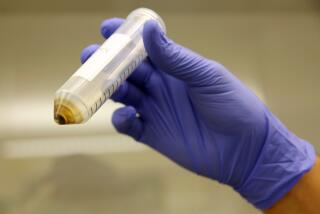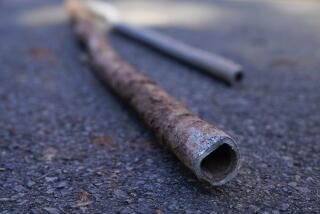FDA Proposes Tougher Rules for Bottled Water
- Share via
WASHINGTON — The federal government Thursday proposed more stringent standards for bottled water labels, hoping to clarify for consumers the differences between mineral water, distilled water, spring water and others.
Consumers are entitled to know the source of bottled water, as well as precisely what it contains, the Food and Drug Administration said in announcing the proposals. They become official on Tuesday and are expected to become final in six months, following public comment. The actual changes in the labels would occur in about a year.
The agency emphasized that the new rules were not being developed because of any health hazards from bottled water but simply to ensure the labeling is truthful.
“People should know what they are getting,” said FDA Commissioner David A. Kessler. “If the label says it’s mineral water, it should be mineral water. If it’s from a municipal water source, the water should be so labeled.”
The FDA also announced a final regulation that would set a ceiling on the levels of lead and other substances--such as copper, certain pesticides and other chemicals--that are permissible in bottled water to ensure it is at least as safe as regular tap water.
Under that regulation, lead in bottled water could not exceed 5 parts per billion, compared to 15 parts per billion allowed by the Environmental Protection Agency in public water systems.
The FDA standards are stricter than EPA’s because lead leaches into tap water from distribution pipes, whereas “there is no distribution piping in the bottled water system,” one FDA official said.
The $2-billion-a-year bottled water industry--which had petitioned the agency for tougher regulations--is expected to welcome the changes.
“These regulations will provide a comprehensive federal structure . . . and assure consumers their bottled water meets the highest quality standards,” said Sylvia Swanson, executive vice president of the International Bottled Water Assn.
Most consumers purchase bottled water because they prefer the taste or because they perceive it to be safer than tap water.
While it is generally believed that bottled water is safe, the congressional watchdog General Accounting Office in 1991 urged the FDA to set stricter standards. In addition, the House Energy and Commerce Committee, chaired by Rep. John D. Dingell (D-Mich.), was weighing whether to draft legislation that would impose new standards for bottled water.
The proposed regulation defines mineral water, for example, as water that contains at least 250 parts per million in total dissolved minerals and water that has come from a source “tapped at one or more bore holes or springs, originating from a geologically and physically protected underground water source.”
The federal levels for mineral water are at odds with stricter California regulations and are expected to preempt them, FDA officials said. The California regulation requires mineral water sold in the state to contain a minimum of 500 parts per million in dissolved minerals.
The proposed rules also stipulate that water labeled “spring” must come from an underground formation from which water flows naturally to the surface, or would if it were not collected underground. “Spring” water would have to be collected at the spring or through a bore hole next to the point where it emerges, the FDA said.
“Artesian” water must come from an artesian well in which subterranean pressure pushes the water at least part of the way toward the surface.
Carbonated waters, such as tonic, soda water, club soda and seltzer, are exempt because they are considered soft drinks. But carbonated mineral waters are not.
The proposals also say that bottled water whose source is a municipal water supply must say so on the label. The requirement would be dropped only if the municipal water was treated in such a way that it qualified as “distilled” or “purified” water.
The regulations also would require that bottled waters marketed for infants indicate that the water is not sterile.
More to Read
Inside the business of entertainment
The Wide Shot brings you news, analysis and insights on everything from streaming wars to production — and what it all means for the future.
You may occasionally receive promotional content from the Los Angeles Times.










